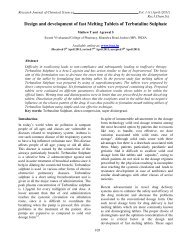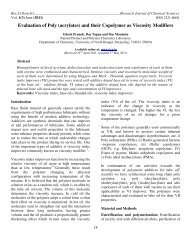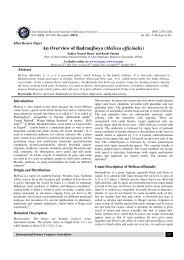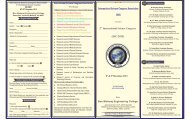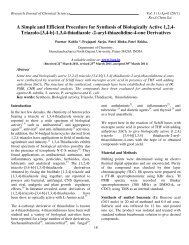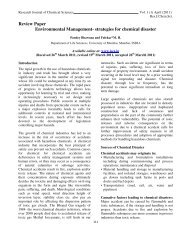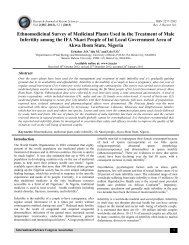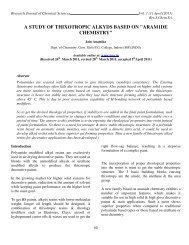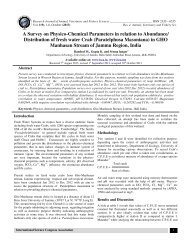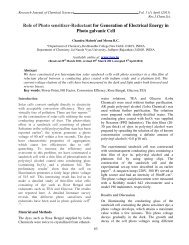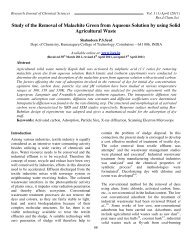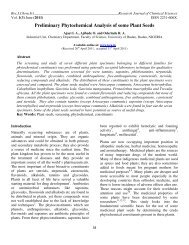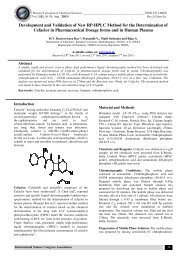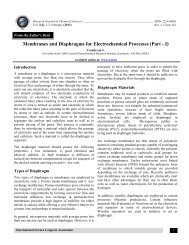Transport Phenomena Analysis for Evaluating the Optimum ... - ISCA
Transport Phenomena Analysis for Evaluating the Optimum ... - ISCA
Transport Phenomena Analysis for Evaluating the Optimum ... - ISCA
You also want an ePaper? Increase the reach of your titles
YUMPU automatically turns print PDFs into web optimized ePapers that Google loves.
Res.J.Chem.Sci.________________________________________________________________Research Journal of Chemical Sciences<br />
Vol. 1(3) June (2011) ISSN 2231-606X<br />
<strong>Transport</strong> <strong>Phenomena</strong> <strong>Analysis</strong> <strong>for</strong> <strong>Evaluating</strong> <strong>the</strong> <strong>Optimum</strong> Operating<br />
Conditions of Reverse Osmosis Processes<br />
Abstract<br />
Jassim Ala’a Abdulrazaq<br />
Chemical Engineering Department, Engineering College, University of Basrah, IRAQ<br />
Available online at: www.isca.in<br />
(Received 25 th April 2011, revised 3 nd May 2011, accepted 31 st May 2011)<br />
In this work, a ma<strong>the</strong>matical model <strong>for</strong> predicting <strong>the</strong> per<strong>for</strong>mance of reverse osmosis (RO) desalination<br />
plants was developed. The proposed model is based on basic transport equations of salt and water across<br />
<strong>the</strong> membrane. The influence of operating variables on <strong>the</strong> separation efficiency of RO processes can be<br />
evaluated by depending on <strong>the</strong> equations of transport phenomena. The <strong>the</strong>oretical predication produced<br />
by <strong>the</strong> developed model was compared with <strong>the</strong> normalized data obtained by Saehan company software<br />
CSM2000-program. The comparison indicated that agreement of <strong>the</strong>oretical values relative to normalized<br />
values is about 85%. For specifying <strong>the</strong> optimum operating conditions, <strong>the</strong> optimization analysis was<br />
carried out by depending on <strong>the</strong> Modifi cation Hook and Jeeves method. The proposed analysis applied a<br />
nonlinear objective function representing <strong>the</strong> concentration of product water as a function of operating<br />
conditions (feed water concentration, operating pressure, and percent recovery).<br />
The optimum concentration of permeate water is governed relative to percent recovery with range about<br />
(10-46.67%), <strong>the</strong> test is repeated <strong>for</strong> different values of feed water concentration (1000, 3000, and 10000<br />
ppm). The results have shown that, <strong>the</strong> average of improvement in <strong>the</strong> optimum values of permeate<br />
concentration is about 67%. Also, <strong>the</strong> optimum concentration of permeate water is inspected <strong>for</strong> feed<br />
water concentration with range (500-10000 ppm), <strong>the</strong> range of increasing in <strong>the</strong> optimum permeate<br />
concentration is 55.8%. Fur<strong>the</strong>rmore, <strong>the</strong> optimum concentration of permeate water is computed <strong>for</strong><br />
range of applied pressures in arrange (6.5-25 bar). The results indicated that, when <strong>the</strong> average<br />
operating pressures was increased by 12.7%, <strong>the</strong> quality of permeate water was improved by 18.8%.<br />
Key words: Desalination, efficiency, optimization, operation conditions.<br />
Introduction<br />
The increasingly broad range of requirements of<br />
purified water due to <strong>the</strong> development of all aspects<br />
in our lives has been motivated <strong>the</strong> water treatment<br />
industry to refine existing techniques, combine<br />
methods and explore new water purification<br />
technologies.<br />
A number of technologies have been developed,<br />
However, reverse osmosis and multi stage flash<br />
evaporation are considered to be <strong>the</strong> main methods,<br />
which are applied in large-scale plants of <strong>the</strong> more<br />
than 7500 water desalination plants in operating<br />
worldwide, 60% are located in <strong>the</strong> Middle East.<br />
Membrane based separation processes have become<br />
<strong>the</strong> important unite operations <strong>for</strong> concentration and<br />
purification of solutions. These processes offer many<br />
advantages over conventional separation processes<br />
such as low operating cost (less energy intensive),<br />
case of operation under ambient temperature, where<br />
no phase change is involved 1 .<br />
<strong>Transport</strong> of solvent or solutes through membranes<br />
can occur by different mechanisms, depending on<br />
<strong>the</strong> structure and nature of <strong>the</strong> membrane 2 .<br />
Many types of membrane filtration are basically<br />
identical in process and differ only in <strong>the</strong> size of <strong>the</strong><br />
particles to be separated and <strong>the</strong> nature of membrane<br />
used. All <strong>the</strong>se processes use <strong>the</strong> applied pressure<br />
with semi-permeable membranes to separate feed<br />
26
Res.J.Chem.Sci.________________________________________________________________Research Journal of Chemical Sciences<br />
Vol. 1(3) June (2011) ISSN 2231-606X<br />
water stream into permeate and concentrated or brine<br />
streams.<br />
Process optimization is one of <strong>the</strong> main areas in<br />
chemical process design and analysis. The major<br />
feature of <strong>the</strong> area is that it provides a systematic<br />
frame work <strong>for</strong> improving <strong>the</strong> design and operation<br />
of chemical processes.<br />
Never<strong>the</strong>less, from a practical point of view, <strong>the</strong><br />
main objective <strong>for</strong> water desalination plants relative<br />
to industrial fields is <strong>the</strong> capability of using <strong>the</strong><br />
water production <strong>for</strong> industrial fields such as,<br />
cooling towers, heating systems and o<strong>the</strong>r purposes.<br />
These systems are essential to improve <strong>the</strong> quality of<br />
water with a high degree of purification.<br />
Consequently, <strong>the</strong> two stages of RO principles have<br />
been applied to increase <strong>the</strong> quality of desalinated<br />
water.<br />
As mentioned above, <strong>the</strong> quality of permeate is<br />
considered <strong>the</strong> main characteristic that must be under<br />
control and monitoring. There are various manners<br />
that can be used to improve <strong>the</strong> quality of<br />
desalinated water, as follows:<br />
The ability of using <strong>the</strong> brackish water with low<br />
salinity as raw water to RO plants after pretreatment.<br />
Operating <strong>the</strong> RO plants under high recovery percent<br />
or high applied pressure.<br />
Selecting professional types of membranes with high<br />
salt passage and percent recovery.<br />
Increasing <strong>the</strong> efficiency of pretreatment systems <strong>for</strong><br />
reducing <strong>the</strong> influence of fouling <strong>the</strong>n, saving <strong>the</strong><br />
membranes <strong>for</strong> operation under high efficiency. The<br />
ability of using <strong>the</strong> developed pretreatment<br />
technology, such as Nano-filtration systems is<br />
considered one of <strong>the</strong> professional methods <strong>for</strong><br />
solving <strong>the</strong> fouling problems.<br />
The capability of applying <strong>the</strong> two stages of RO<br />
principle.<br />
In <strong>the</strong> present work, <strong>the</strong> optimization concept will<br />
focus on <strong>the</strong> first and second reasons and tested <strong>the</strong><br />
influence of raw water quality, percent recovery and<br />
pressure on <strong>the</strong> quality of water production to obtain<br />
a better understanding of <strong>the</strong> characteristics and<br />
behavior of selected membrane module, and how<br />
external factors such as feed properties and utility<br />
affect on <strong>the</strong> optimal operation of RO system.<br />
Ma<strong>the</strong>matical analysis<br />
The Kimura-Sourirajan analysis 3 describes <strong>the</strong><br />
ma<strong>the</strong>matical equations <strong>for</strong> <strong>the</strong> solvent and solute<br />
transport through <strong>the</strong> membrane by depending on<br />
mass transfer phenomena. The transport of solvent is<br />
proportional to <strong>the</strong> effective pressure where <strong>the</strong><br />
proportional constant is called pure water<br />
permeability:<br />
N = A* ∆P<br />
…… (1)<br />
B<br />
The effective pressure can be defined as <strong>the</strong><br />
difference between <strong>the</strong> feed pressure and osmotic<br />
pressure across <strong>the</strong> membrane as follows:<br />
∆P = P − ∆π …….. (2)<br />
So,<br />
∆ P = P − π ( X A<br />
) −π<br />
( X )]……. (3)<br />
[<br />
3 A2<br />
Then, <strong>the</strong> pure water flux can be written as follows:<br />
N = A [ P −π ( X A<br />
) + π ( X )]…... (4)<br />
B<br />
*<br />
2 A3<br />
While <strong>the</strong> transport of solute is proportional with <strong>the</strong><br />
concentration difference cross <strong>the</strong> membrane; so,<br />
D<br />
N A<br />
= ( C X − C X ) 3 …… (5)<br />
δ<br />
AM<br />
M 2 AM 2 M 3 AM<br />
The above equations can be trans<strong>for</strong>med by<br />
assuming a simple linear relationship between <strong>the</strong><br />
concentration of solute in <strong>the</strong> solution phase and<br />
membrane phase 4 . Thus <strong>the</strong> following definition can<br />
be predicted:-<br />
C<br />
2<br />
X<br />
A2<br />
= KC<br />
M 2<br />
X<br />
AM 2<br />
…… (6)<br />
C X = KC X …... (7)<br />
3 A3<br />
M 3 AM 3<br />
Now, equation (5) can be written as:<br />
DAM<br />
N<br />
A<br />
= ( C2<br />
X A2 − C3<br />
X<br />
A3)<br />
……. (8)<br />
Kδ<br />
By depending on <strong>the</strong> principle of material balances,<br />
<strong>the</strong> total flux can be written as follows:-.<br />
N = N X + N X …….. (9)<br />
A<br />
A<br />
*<br />
A3 B<br />
*<br />
A3<br />
27
Res.J.Chem.Sci.________________________________________________________________Research Journal of Chemical Sciences<br />
Vol. 1(3) June (2011) ISSN 2231-606X<br />
Substituting <strong>the</strong> last equation in equation (6) results:<br />
DAM<br />
1−<br />
X<br />
A3<br />
N<br />
B<br />
= ( )( )( C2<br />
X<br />
A2<br />
− C3<br />
X<br />
A3)<br />
…… (12)<br />
Kδ<br />
X<br />
A3<br />
The solute transfer from <strong>the</strong> concentrated boundary<br />
solution is represented by <strong>the</strong> following relation 5 :-<br />
dX<br />
A<br />
N<br />
A<br />
= X<br />
A<br />
( N<br />
A<br />
+ N<br />
B<br />
) − DABC1<br />
……. (13)<br />
dZ<br />
Whereas <strong>the</strong> flux of <strong>the</strong> solute in <strong>the</strong> region (0
Res.J.Chem.Sci.________________________________________________________________Research Journal of Chemical Sciences<br />
Vol. 1(3) June (2011) ISSN 2231-606X<br />
pressure, permeate flow and salt rejection. For<br />
efficient evaluation of RO system, it is necessary to<br />
compare between <strong>the</strong>se two variables at <strong>the</strong> same<br />
conditions.<br />
During <strong>the</strong> operation stages, system conditions such<br />
as operating pressure, feed temperature, percent<br />
recovery and feed concentration can vary<br />
considerably. Two simple equations show <strong>the</strong><br />
relationship among <strong>the</strong> operation parameters. The<br />
first equation express <strong>the</strong> effects of operation<br />
variables on permeate water flow rate as follows:-<br />
∆P<br />
fc<br />
Q = Aπ )* S*<br />
TCF*<br />
FF*(<br />
P −∆π<br />
− −P<br />
) (29)<br />
p<br />
(<br />
f<br />
P<br />
2<br />
The difference of osmotic pressure cross <strong>the</strong><br />
membranes and its value can be obtained as<br />
follows:-<br />
∆ π = π − ..... (30)<br />
π P<br />
The value of osmotic pressure of <strong>the</strong> water on <strong>the</strong><br />
high pressure side of <strong>the</strong> membrane can be expressed<br />
as follows 7 :-<br />
Where:-<br />
C<br />
fc<br />
π = π<br />
f<br />
* * PF …… (31)<br />
C<br />
f<br />
ln[1/(1 − R)]<br />
C<br />
fc<br />
= C<br />
f<br />
* …… (32)<br />
R<br />
The pure water permeability coefficient varies<br />
depending on <strong>the</strong> average osmotic pressure and<br />
specific to <strong>the</strong> element itself.<br />
The salt concentration in permeate water is affected<br />
by several variables as shown in <strong>the</strong> following<br />
equation 8 :-<br />
DAM<br />
S<br />
CP = * Cfc<br />
* PF*<br />
TCF*<br />
…… (33)<br />
kδ<br />
Q<br />
The objective function relies on a large number of<br />
quantities that are separated into variables, with<br />
respect to which <strong>the</strong> function is minimized, and <strong>the</strong><br />
parameters which are regarded as constants during<br />
<strong>the</strong> optimization calculation.<br />
Finally, <strong>the</strong> objective function is optimized by using<br />
<strong>the</strong> modified Hook and Jeeves optimization method.<br />
Results and Discussion<br />
Effect of Percent Recovery on Quality of<br />
Permeate Water: The design of recovery rate of<br />
new commercial RO systems has been increased<br />
subsequently to <strong>the</strong> availability of membrane<br />
elements with increasingly higher salt rejection.<br />
Figures (1), (2), and (3) show <strong>the</strong> change in optimum<br />
product water salinity as a function of percent<br />
recovery and permeate flow rate at different feed<br />
water flow rates. The calculation have repeated <strong>for</strong><br />
various range of feed concentration, (1000, 3000,<br />
and 10000 ppm) respectively, and it’s shown that <strong>the</strong><br />
permeate concentration was increased with<br />
increasing of feed concentration. All <strong>the</strong> figures<br />
show that when <strong>the</strong> percent recoveries of water<br />
increases, <strong>the</strong> optimum permeate water<br />
concentration will also increase. However, <strong>the</strong><br />
higher recovery and higher permeate flux require<br />
higher feed pressure. The increase in feed pressure<br />
with recovery rate at a given permeate flux is due to<br />
increasing <strong>the</strong> average feed salinity and osmotic<br />
pressure. The results shown that, <strong>the</strong> average of<br />
improvement in <strong>the</strong> optimum values of permeate<br />
concentration is about 67%<br />
Effect of Feed Water Salinity on <strong>the</strong> Quality of<br />
Permeate: The purpose of optimization section is to<br />
achieve <strong>the</strong> optimum product characteristics by <strong>the</strong><br />
operation of RO systems at <strong>the</strong> optimum operation<br />
conditions.<br />
The water concentration is considered as one of <strong>the</strong><br />
significant parameters that affect <strong>the</strong> quality of<br />
permeated water. Generally, as <strong>the</strong> feed water<br />
concentration increases, <strong>the</strong> values of total dissolved<br />
solids or conductivities of permeated water will be<br />
increased. Consequently, <strong>the</strong> operation requirements<br />
will be more difficult and <strong>the</strong> membrane life time<br />
29
Res.J.Chem.Sci.________________________________________________________________Research Journal of Chemical Sciences<br />
Vol. 1(3) June (2011) ISSN 2231-606X<br />
will be reduced due to <strong>the</strong> chemical cleaning<br />
repetition <strong>for</strong> removing <strong>the</strong> inorganic salt<br />
precipitation on <strong>the</strong> membrane surfaces.<br />
Figure (4) illustrates <strong>the</strong> proportional relation<br />
between raw water concentration and optimum<br />
permeates concentration. As <strong>the</strong> raw water<br />
concentration increases, <strong>the</strong> diffusion of salts from<br />
<strong>the</strong> high concentrate side will be increased.<br />
Consequently, <strong>the</strong> concentration of permeate will<br />
also increase. During <strong>the</strong> continuous operation, <strong>the</strong><br />
negative affects of salt concentration on <strong>the</strong><br />
membrane efficiency will appear due to <strong>the</strong><br />
inorganic salt precipitation. Moreover, <strong>the</strong> influences<br />
of concentration polarization phenomena will<br />
contribute to reduce <strong>the</strong> quality of permeate due to<br />
<strong>the</strong> increase in <strong>the</strong> feed water concentration.<br />
The proposed Figure shows <strong>the</strong> optimum value of<br />
permeate concentration <strong>for</strong> range of water<br />
concentration between (500-3000) ppm. The<br />
permeate concentration computed as a function of<br />
feed water quantity and permeate recovery.<br />
Effect of Applied Pressure on <strong>the</strong> Quality of<br />
Permeate Water: Reverse osmosis systems<br />
equipped with spiral wound membrane elements are<br />
designed to operate at constant flux rate (i.e., to<br />
produce a constant permeate flow). Over operation<br />
time, <strong>the</strong> feed pressure is adjusted to compensate <strong>the</strong><br />
influence of feed water temperature, salinity and<br />
permeate flux decline due to fouling or compaction<br />
of <strong>the</strong> RO membrane.<br />
The applied pressure represents ano<strong>the</strong>r operating<br />
variable that influence <strong>the</strong> efficiency of RO plants.<br />
Any variation in its values will effect on <strong>the</strong><br />
properties of permeate stream. The <strong>for</strong>m of objective<br />
function that describes <strong>the</strong> concentration of permeate<br />
water is a function of various parameters, and <strong>the</strong><br />
pressure has a large affect on <strong>the</strong> quality of water<br />
production. Figures (5) and (6) present <strong>the</strong> effect of<br />
applied pressure on <strong>the</strong> salinity of optimum permeate<br />
water <strong>for</strong> various values of feed water rates and raw<br />
water concentration. The figures indicate <strong>the</strong><br />
inversely relation between <strong>the</strong>m. As <strong>the</strong> applied<br />
pressure increases, <strong>the</strong> optimum quantity of<br />
permeate water will also improve due to <strong>the</strong> dilution<br />
effects. ). The results indicated that, when <strong>the</strong><br />
average operating pressures increased by 12.7%, <strong>the</strong><br />
quality of permeate water is improvement by 18.8%.<br />
References<br />
1. Michael J.S., Membrane Based Liquid<br />
Separation System, CEP, 32, (1986)<br />
2. Clean Water Program “Membrane Separation<br />
Treatment”. http/ en.wikipedia.org/Reverse<br />
osmosis.<br />
3. Kimmura S., and Sourirajan S., <strong>Analysis</strong> of Data<br />
in Reverse Osmosis with Porous Cellulose<br />
Acetate Membrane Used; AIChE, 297 (1967)<br />
4. Sourirajan S., Reverse Osmosis; Academic press,<br />
(1970)<br />
5. Bird R., Stewart W. and Lightfood E., <strong>Transport</strong><br />
phenomenon, Wiley, (1960)<br />
6. Ghin S., Cannahhan R., Bager M., Mass Transfer<br />
in RO TCF Membrane Dependence on <strong>the</strong> Salt<br />
Physical and Thermodynamic Parameters,<br />
Desalination, (57), 385 (2003)<br />
7. Technical Manual Excerpts, Filmetec<br />
Membranes, DOW Company, www.<br />
Filmetec.com.<br />
8. Technical Manual, SaehaneCompany, www.<br />
Saehan CSM.com.<br />
30
Res.J.Chem.Sci.________________________________________________________________Research Journal of Chemical Sciences<br />
Vol. 1(3) June (2011) ISSN 2231-606X<br />
Nomenclatures<br />
A<br />
C<br />
Pure water permeability constant.<br />
Molar concentration of <strong>the</strong> solution.<br />
mol/m 2 .s.bar<br />
mol/m 3<br />
C<br />
1<br />
,C 2<br />
, C 3<br />
C<br />
C<br />
M 2,<br />
M 3<br />
Molar concentration in <strong>the</strong> solution phase 1, phase 2 and phase 3 respectively. mol/m 3<br />
X A 2, X<br />
A<br />
Molar concentrations in <strong>the</strong> membrane phase in equilibrium with 3<br />
respectively.<br />
C<br />
fc<br />
Average feed-concentrate concentration.<br />
D<br />
AB<br />
Diffusivity of solute in <strong>the</strong> feed solution.<br />
D AM<br />
/ Kδ Solute transport parameter. m/s<br />
FF<br />
Fouling factor.<br />
k Mass transfer coefficient on <strong>the</strong> high pressure side of <strong>the</strong> membrane. m/s<br />
K<br />
Interfacial equilibrium constant <strong>for</strong> solute.<br />
L Length of <strong>the</strong> membrane element. m<br />
mol/m 3<br />
mol/m 3<br />
m 2 /s<br />
N<br />
A<br />
Solute flux through <strong>the</strong> membrane. mol/m 2 .s<br />
N<br />
B<br />
Solvent flux through <strong>the</strong> membrane. mol/m 2 .s<br />
P Operating pressure. bar<br />
P Permeate pressure. bar<br />
P<br />
P<br />
F<br />
Feed pressure. bar<br />
P . W . P Pure water rate. kg/h<br />
Q , Q , Q Flow rate in feed, permeate and brine respectively. m 3 /hr<br />
F<br />
PF<br />
p<br />
R<br />
Concentration polarization.<br />
S Effective area of <strong>the</strong> membrane. m 2<br />
T Temperature ο K<br />
TCF Temperature factor constant.<br />
X X Molar fraction of solute in solution 2 and 3 respectively.<br />
A2, A3<br />
X X Molar fractions of solute in membrane phase in equilibrium with X A 2, X<br />
A3<br />
AM 2,<br />
AM 3<br />
respectively.<br />
TDS Total dissolved Salt mg/l<br />
z Thickness of <strong>the</strong> concentrated boundary layer. m<br />
dp Pressure drop cross <strong>the</strong> membranes. bar<br />
31
Res.J.Chem.Sci.________________________________________________________________Research Journal of Chemical Sciences<br />
Vol. 1(3) June (2011) ISSN 2231-606X<br />
3 0<br />
20<br />
3 00<br />
Permeate Concentration (ppm)<br />
25<br />
20<br />
15<br />
10<br />
5<br />
15<br />
10<br />
5<br />
Permeate Flow Rate (m 3 /h)<br />
Permeate Concentration (ppm)<br />
250<br />
200<br />
150<br />
100<br />
50<br />
20<br />
16<br />
12<br />
8<br />
4<br />
Permeate Flow Rate (m 3 /h)<br />
0<br />
0<br />
0 10 20 30 40 50<br />
8 0<br />
Recovery %<br />
20<br />
0<br />
0 10 20 30 40 50<br />
Recovery %<br />
0<br />
Permeate Concentration (ppm)<br />
6 0<br />
4 0<br />
2 0<br />
Permeate Concentration (ppm) (ppm)<br />
15<br />
10<br />
5<br />
Permeate Flow Rate (m 3 /h)<br />
C f<br />
=1000, 3000, 10000ppm<br />
Q f =20 m 3 /h<br />
Q f =30 m 3 /h<br />
Q f =40 m 3 /h<br />
0<br />
10 20 30 40 5 0<br />
0<br />
Recovery %<br />
Figures-1,2 and 3: show <strong>the</strong> Influence of percent recovery and permeate flow rate on <strong>the</strong> optimum<br />
concentration of permeate water For different feed water concentration<br />
25<br />
7 0<br />
Permeate Concentration (ppm)<br />
20<br />
15<br />
10<br />
5<br />
6 0<br />
5 0<br />
4 0<br />
30<br />
20<br />
Feed Flow Rate (m 3 /h)<br />
R=25%<br />
R =33.33%<br />
R =45%<br />
10<br />
0<br />
0<br />
0 500 1 00 0 1500 2000 250 0 30 0 0 3500<br />
Feed concentration ppm<br />
Figure-4: Influence of feed concentration and feed flow rate on <strong>the</strong> optimum concentration of permeate water<br />
32
Res.J.Chem.Sci.________________________________________________________________Research Journal of Chemical Sciences<br />
Vol. 1(3) June (2011) ISSN 2231-606X<br />
Feed Pressure (bar)<br />
1 6<br />
60<br />
160<br />
60<br />
Permeate Concentration (ppm)<br />
14<br />
50<br />
12<br />
40<br />
10<br />
30<br />
8<br />
20<br />
6<br />
6 8 10 12 14<br />
Feed Flow Rate (m 3 /h)<br />
Permeate Concentration (ppm)<br />
50<br />
120<br />
40<br />
80<br />
30<br />
40<br />
20<br />
10<br />
18.0 19.5 21.0 22.5 24.0 25.5<br />
Feed Flow Rate (m 3 /h)<br />
4 8<br />
Feed Pressure (bar)<br />
Feed Pressure (bar)<br />
6 0<br />
4 2<br />
Feed Flow Rate (m 3 /h)<br />
36<br />
30<br />
24<br />
5 0<br />
40<br />
3 0<br />
Permeate Flow Rate (m 3 /h)<br />
C f<br />
=1000, 3000, 100000 ppm<br />
Q p =7.5 m 3 /h<br />
Q p =10 m 3 /h<br />
1 8<br />
Q p =15 m 3 /h<br />
1 2<br />
9. 0 10 . 5 12 . 0 1 3 . 5 15.0<br />
2 0<br />
Recovery %<br />
Figures-5, 6 and 7: show <strong>the</strong> Influence of feed pressure and feed flow rate on <strong>the</strong> optimum concentration of<br />
permeate water with various feed water concentration.<br />
33



